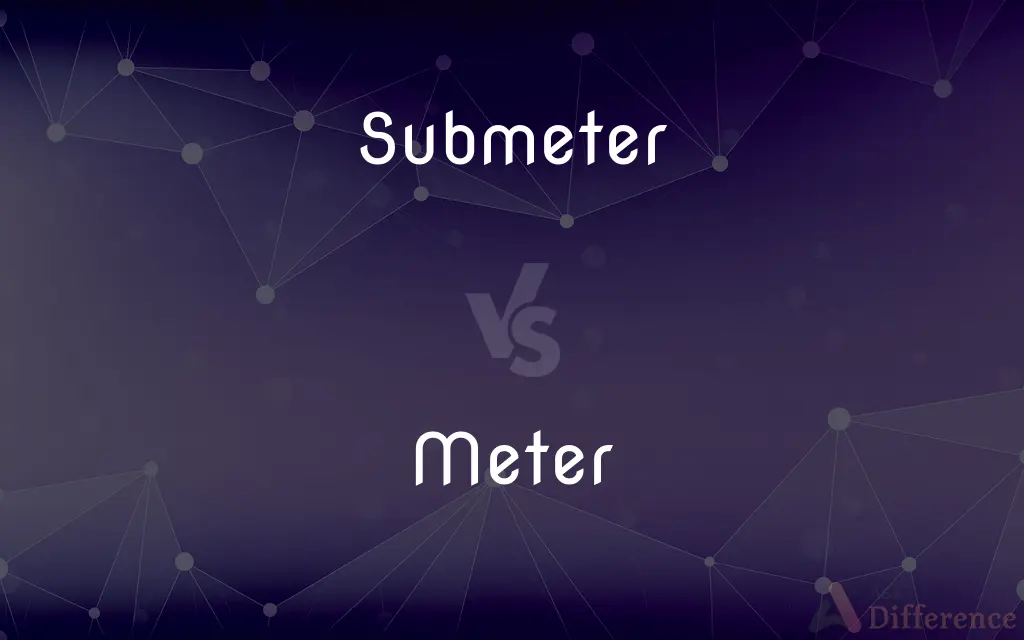Submeter vs. Meter — What's the Difference?
Edited by Tayyaba Rehman — By Urooj Arif — Updated on March 31, 2024
A submeter measures utility usage for a specific area or equipment within a larger property, allowing for individual billing, while a meter measures total consumption for a property or system.

Difference Between Submeter and Meter
Table of Contents
ADVERTISEMENT
Key Differences
Submeters are installed to monitor the utility consumption (like electricity, water, or gas) of individual units, apartments, or specific equipment within a larger property. This setup enables property owners to bill tenants or departments accurately for their actual usage. Meters, on the other hand, are generally used to measure the total consumption of a utility for an entire property or system, providing a single consumption figure that reflects the overall use.
While submeters play a crucial role in utility management by providing detailed insights into specific usage patterns, main meters offer a broader view, measuring the total consumption that the utility company uses for billing purposes. Submeters thus facilitate the equitable distribution of utility costs among multiple users within a property, whereas meters are typically the point of reference for the utility provider to charge the property owner.
The installation of submeters allows property owners to encourage conservation among tenants or departments by making them directly responsible for their utility costs. In contrast, a meter does not provide this level of detail, often leading to a single bill that the property owner must divide among tenants or departments based on estimates or square footage, which might not reflect actual usage.
Submeters can also be used to identify areas of high usage or leaks within a system, allowing for targeted maintenance and potentially saving money on utilities. Meanwhile, a meter provides no such granularity, only indicating the property's overall consumption level without specifying where usage is highest.
Despite their different applications, both submeters and meters are essential for effective utility management. Submeters add an extra layer of detail useful for managing costs within a property, while meters serve as the primary tool for utility companies to measure and bill for total consumption.
ADVERTISEMENT
Comparison Chart
Purpose
Measures utility usage for specific areas or equipment within a property.
Measures total utility consumption for a property or system.
Usage
Enables individual billing and monitoring of specific consumption patterns.
Used by utility companies for billing based on total consumption.
Benefit
Facilitates equitable distribution of utility costs and encourages conservation.
Provides a single consumption figure for the entire property or system.
Detail
Offers detailed insights into usage for targeted maintenance and cost management.
Provides a broad overview of consumption without specific usage details.
Application
Installed within a property, beyond the main utility meter.
Typically the first point of measurement by a utility provider at a property.
Compare with Definitions
Submeter
A device to measure utility usage in specific parts of a property.
The landlord installed submeters in each apartment to accurately bill tenants for electricity.
Meter
A device that measures the total utility consumption of a property.
The electric meter outside the building showed the total power used in a month.
Submeter
Allows for detailed monitoring and management of resources.
Water submeters were used to detect leaks in different sections of the building.
Meter
Used by utility companies for billing purposes.
The water meter reading was sent to the utility company for billing.
Submeter
Facilitates equitable utility cost distribution.
The factory used submeters to bill departments for their actual energy use.
Meter
Reflects the primary point of utility measurement.
The building's main electricity meter was upgraded to support smart metering features.
Submeter
Used for tracking individual equipment or tenant utility consumption.
Submeters on the HVAC units helped identify the most energy-intensive equipment.
Meter
Provides an overall consumption figure.
The gas meter indicated a significant increase in usage during the winter months.
Submeter
Promotes conservation by attributing costs directly to usage.
With submetering, tenants became more conscious of their water consumption.
Meter
Essential for managing utility supply to a property.
The new digital meter allowed for remote monitoring of electricity consumption.
Submeter
A utility meter, especially for electricity, that allows for the monitoring of usage on a portion of a distribution network, especially not owned by a utility, past a main meter.
Meter
The measured arrangement of words in poetry, as by accentual rhythm, syllabic quantity, or the number of syllables in a line.
Submeter
(transitive) To install a submeter for.
Meter
A particular arrangement of words in poetry, such as iambic pentameter, determined by the kind and number of metrical units in a line.
Submeter
To charge for electricity usage measured by a submeter.
Meter
The rhythmic pattern of a stanza, determined by the kind and number of lines.
Submeter
On a scale based on units smaller than meters.
Meter
Division into measures or bars.
Meter
A specific rhythm determined by the number of beats and the time value assigned to each note in a measure.
Meter
The international standard unit of length, approximately equivalent to 39.37 inches. It was redefined in 1983 as the distance traveled by light in a vacuum in 1/299,792,458 of a second. See Table at measurement.
Meter
Any of various devices designed to measure time, distance, speed, or intensity or indicate and record or regulate the amount or volume, as of the flow of a gas or an electric current.
Meter
A postage meter.
Meter
A parking meter.
Meter
To measure with a meter
Meter a flow of water.
Meter
To supply in a measured or regulated amount
Metered the allotted gasoline to each vehicle.
Meter
To imprint with postage or other revenue stamps by means of a postage meter or similar device
Metering bulk mail.
Meter
To provide with a parking meter or parking meters
Meter parking spaces.
Meter
A device that measures things.
Meter
A parking meter or similar device for collecting payment.
Gas meter
Meter
One who metes or measures.
A labouring coal-meter
Meter
(American spelling) The base unit of length in the International System of Units (SI), conceived as 1/10,000,000 of the distance from the North Pole to the Equator, and now defined as the distance light will travel in a vacuum in 1/299,792,458 seconds.
Meter
(American spelling) The overall rhythm of a song or poem; particularly, the number of beats in a measure or syllables in a line.
Meter
(obsolete) A poem.
Meter
(American spelling) A line above or below a hanging net, to which the net is attached in order to strengthen it.
Meter
To measure with a metering device.
Meter
To imprint a postage mark with a postage meter.
Meter
To regulate the flow of or to deliver in regulated amounts (usually of fluids but sometimes of other things such as anticipation or breath).
Meter
One who, or that which, metes or measures. See Coal-meter.
Meter
An instrument for measuring, and usually for recording automatically, the quantity measured.
Meter
A line above or below a hanging net, to which the net is attached in order to strengthen it.
Meter
Rhythmical arrangement of syllables or words into verses, stanzas, strophes, etc.; poetical measure, depending on number, quantity, and accent of syllables; rhythm; measure; verse; also, any specific rhythmical arrangements; as, the Horatian meters; a dactylic meter.
The only strict antithesis to prose is meter.
Meter
A poem.
Meter
A measure of length, equal to 39.37 English inches, the standard of linear measure in the metric system of weights and measures. It was intended to be, and is very nearly, the ten millionth part of the distance from the equator to the north pole, as ascertained by actual measurement of an arc of a meridian. See Metric system, under Metric.
Meter
The basic unit of length adopted under the Systeme International d'Unites (approximately 1.094 yards)
Meter
Any of various measuring instruments for measuring a quantity
Meter
(prosody) the accent in a metrical foot of verse
Meter
Rhythm as given by division into parts of equal time
Meter
Measure with a meter;
Meter the flow of water
Meter
Stamp with a meter indicating the postage;
Meter the mail
Common Curiosities
Can submeters save money?
Yes, by promoting conservation and allowing for targeted maintenance, submeters can lead to significant utility savings.
Who is responsible for reading submeters?
Property owners or managers typically read submeters to determine individual usage for billing purposes.
Why use submeters?
Submeters allow for accurate billing based on individual consumption, promote utility conservation, and help identify specific areas for maintenance.
How does a meter differ from a submeter in terms of billing?
A meter is used for overall billing by the utility company, while submeters enable property owners to bill tenants or departments based on their actual usage.
Can a property have both meters and submeters?
Yes, properties often have a main meter for overall consumption measurement and submeters for detailed monitoring within the property.
What utilities can be measured with submeters?
Submeters can measure various utilities, including electricity, water, gas, and sometimes heat.
Do submeters affect the main meter reading?
No, submeters measure consumption beyond the main meter, not affecting the main meter's reading.
Can submeter data help in energy management?
Yes, detailed consumption data from submeters can be crucial for effective energy management and conservation strategies.
How does a meter benefit the utility provider?
Meters provide utility providers with accurate consumption data for the entire property, simplifying billing and resource management.
Are submeters and meters installed by the utility company?
Meters are usually installed by the utility company, while submeters are installed by property owners or managers.
Share Your Discovery

Previous Comparison
Vacancy vs. Vacant
Next Comparison
Flush vs. FlashAuthor Spotlight
Written by
Urooj ArifUrooj is a skilled content writer at Ask Difference, known for her exceptional ability to simplify complex topics into engaging and informative content. With a passion for research and a flair for clear, concise writing, she consistently delivers articles that resonate with our diverse audience.
Edited by
Tayyaba RehmanTayyaba Rehman is a distinguished writer, currently serving as a primary contributor to askdifference.com. As a researcher in semantics and etymology, Tayyaba's passion for the complexity of languages and their distinctions has found a perfect home on the platform. Tayyaba delves into the intricacies of language, distinguishing between commonly confused words and phrases, thereby providing clarity for readers worldwide.














































